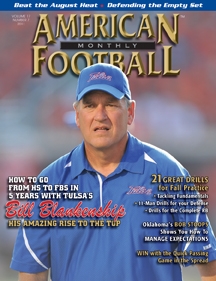Article CategoriesAFM Magazine
|
Your Take – Risky Businessby: Megan Jones© More from this issue Players, parents and coaches across America are being confronted with growing evidence that some young adults participating in impact sports might be experiencing irreversible injuries that put them at risk for compromised mental functioning, personality dysfunction, and early dementia. Chronic Traumatic Encephalopathy (CTE) is a degenerative brain disorder that affects individuals exposed to repetitive brain trauma. Research is showing that CTE is the result of major collisions (concussions) as well as an accumulation of less severe collisions causing sub-concussions, which often go undetected. Players of most impact sports experience some type of collision trauma during practice or competition, but increasing awareness of CTE has focused attention on football and the implications of years of trauma on brain function and health. During each collision, the brain is shaken, causing nerve fibers to be torn and the release of tau (structural protein of nervous tissue) which is a marker for brain injury. Autopsies of injured brain tissue reveal brown spots caused by this protein and, in some cases, brains resemble those of 90-year old dementia patients. A confirmatory diagnosis of CTE can only be made postmortem through autopsy. While few autopsies are performed on athletes of impact sports, there is growing evidence that CTE is a problem. The media has highlighted several former NFL players who have been diagnosed with CTE postmortem. While we might consider CTE as a risk that professional players are willing to make for the rewards of being a professional athlete, similar injuries are also being seen in college, high school, and even middle school. An increasing number of studies are helping us to understand how CTE develops in sport settings. Since impact with other players or the ground is the primary event injuring the brain, researchers are looking at the frequency and severity of impact as well as the equipment intended to protect the head. With increased attention given to CTE, many researchers, coaches and health professionals are exploring options to prevent or limit player impact or improve protective technology. A public health approach to prevent CTE could include improved technology or environmental changes to make it easier for athletes to be protected, education about risk and prevention, and policy change to minimize risk, particularly among the most vulnerable populations. The easiest place to introduce strategies to prevent CTE could be with the coach, since he sets the tone and standards for player behavior during practice and games. Strategies might include limiting contact at practice and not allowing players under a certain age to tackle. Coaching education and certification for concussion-management could be required as part of a standard for training and continuing education. Policy changes to decrease tactics that are commonly used but are not critical to the game could decrease impact traumas. Making kickoffs or punts automatic fair catches would prevent players from using large distances to gain speed and momentum. Removing the 3-point stance from the game could also decrease the likelihood that linemen (most at risk for CTE ) would experience violent collisions. Another important strategy for decreasing CTE is to change the way we discuss hits. Slang phrases like, “getting your bell rung” or “mild concussion” in the media makes the problem seem less serious than it actually is. We should see these injuries as serious threats to players and refer to them as what they really are, brain bleeds. The media plays a large role in glorifying monstrous head-to-head hits. Adolescents who look up to older players see how hits are glorified and normalized as what it takes to be a good player. Instead, the media should describe the dangers associated with these repeated hits and the long-term effects suffered because of them. Finally, fans and parents need to be educated about the brain injury these players experience for their entertainment. The majority of youth who play football will never receive college scholarships or professional contracts for football. It is a high-risk choice of recreation. Those who do play in the more advanced settings do not really understand the vast difference between living with a knee injury the rest of their lives and living with dementia in their 50’s. Fans and parents can support changes in customs and norms related to hits and make it safer for all players to participate in a game they love. I asked current and former players about how easily they thought changes could be made to the game to make it safer. While most were hopeful about changes, they doubted they would change the way they played. They believed if they changed the way they played, the game would “move past them”; they will not be able to keep up with others in the league. In order for the game to become safer, attitudes and beliefs surrounding the game must change. Coaches can have a great impact on encouraging changes that will decrease CTE. Coaches should examine the policies in their respective divisions and look for opportunities to change policy to support safety. In addition, coaches can work together to agree on changes they will make at practice and in the game that support quality play while decreasing the frequency and severity of hits. While the strategies proposed here will not prevent CTE, small changes in individual habits, practices, and game play can reduce players’ risk of developing this devastating and debilitating disease, and spare players and their families unnecessary suffering. |
|
| HOME |
MAGAZINE |
SUBSCRIBE | ONLINE COLUMNISTS | COACHING VIDEOS |
Copyright 2024, AmericanFootballMonthly.com
All Rights Reserved




